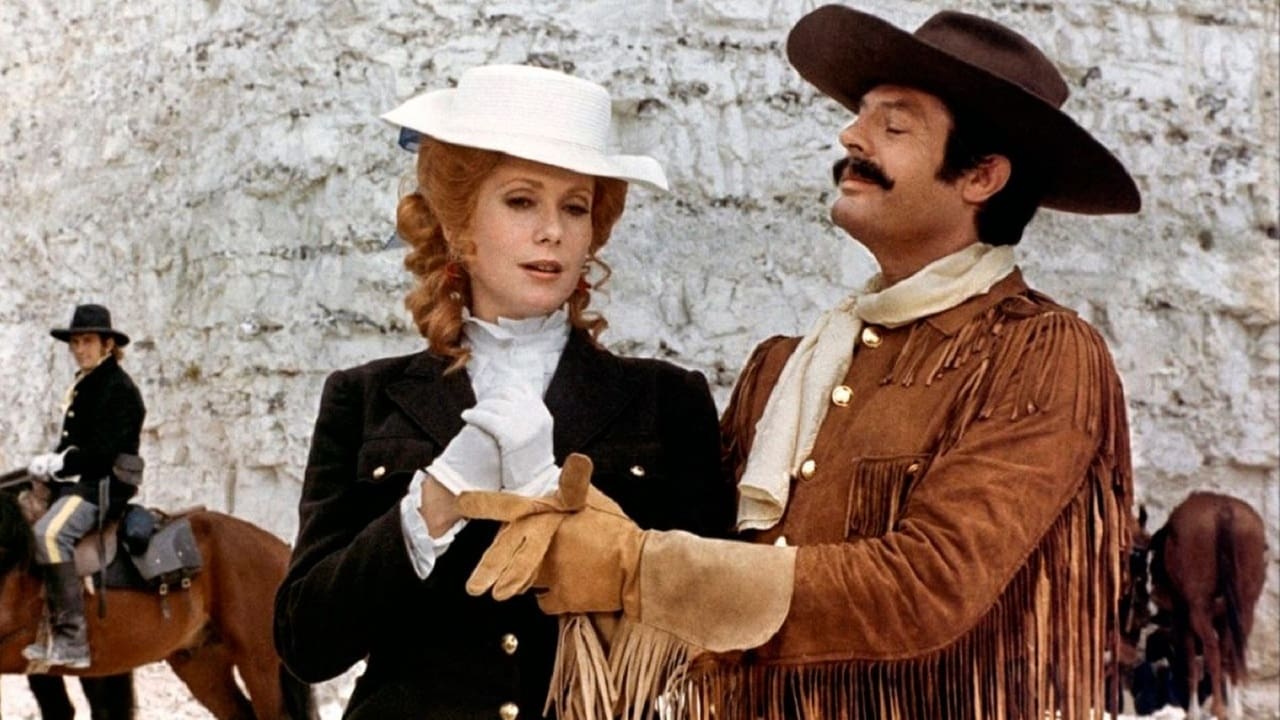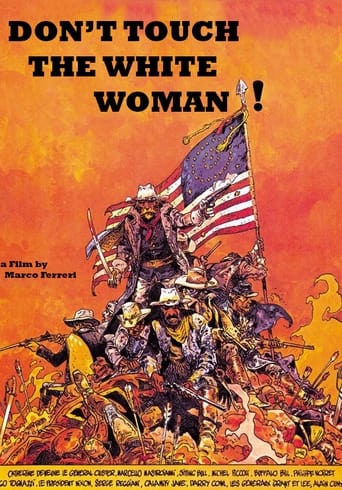Supelice
Dreadfully Boring
Numerootno
A story that's too fascinating to pass by...
Hayleigh Joseph
This is ultimately a movie about the very bad things that can happen when we don't address our unease, when we just try to brush it off, whether that's to fit in or to preserve our self-image.
Zandra
The movie turns out to be a little better than the average. Starting from a romantic formula often seen in the cinema, it ends in the most predictable (and somewhat bland) way.
tony_le_stephanois
General George Custer can't wait to crush the Indians in Marco Ferreri's Touche Pas à la femme blanche. It's the only thing he can talk about. Meanwhile, he also falls in love with Marie-Hélène, who can't be touched by an Indian, especially Custer's informant. The informant awaits his moment.Just another ordinary version of the battle between settlers and Indians at Little Big Horn? Far from it! The ever wayward filmmaker Marco Ferreri chose to film the battle of Little Big Horn at the place where Les Halles - the Parisian vegetable market - was taken down in 1974. In fact, it was actually taken down during the filming of this movie. The demolishers were probably rubbing their eyes in astonishment. Catherine Deneuve, right here, in this mess? I enjoyed the movie immensely. All the actors wear the same deadpan expressions as if they really are blind to the fact that they are acting out a traditional western story in a modern setting. Unlike in Les Visiteurs, no jokes about the confrontation with modernity. The characters just do not seem to see it, as if they live in another dimension. It creates many brilliant moments, such as when a cannon is fired and a building collapses. Or if Custer points to a Coca-Cola advertisement and says: "My wife."
PKazee
1974's DON'T TOUCH THE WHITE WOMAN! is an an odd, farcical critique of Capitalism and Manifest Destiny setting General Custer's Battle of the Little Bighorn in the early'70's with Richard Nixon as President, and a large, controversial, construction pit in Paris, France filling in for the site of the famed Montana massacre. The location of the pit, known as Les Halles, had been Paris's central wholesale marketplace for nearly 800 years before being razed to make way of a multi-tiered commercial business center/modern shopping mall, and - particularly important to the City's growth - a central railroad hub (something that it's helpful to know in order to fully "get" an allegory in the film regarding the need to displace or eliminate the local Natives in order to make way for the railroad). Additional contemporary political commentary surfaces when justifications given for taking action against the Natives, parallel those used by the French against the Algerians, and by both the French and Americans in Vietnam. If all this makes the movie sound thoughtful or fascinating, I am sorry to report that it is neither, the most interesting aspects being the broad performances by an all-star cast led by Catherine Deneuve (Madame Boismonfrais; trans. Freshwood?), Marcello Mastroianni (Gen. Custer), Michel Piccoli (Buffalo Bill), Philippe Noiret (Gen. Terry) and La Cage aux Folles co-star, Ugo Tognazzi as Custer's famed Indian Scout, Mitch Bouyer, portrayed here as a duplicitous chameleon playing both sides, while selling "Indian artifacts" to tourists that are actually made by white women in sweatshop conditions.
bobc-5
Several tribes of Native Americans have taken up residence in a large excavation in the center of modern day Paris. Meeting nearby in an ornate domed room, some wealthy industrialists decide that the savages are impeding progress and must be exterminated. After successfully bribing the head of the army, General Custer is brought in to lead the effort. A portrait of their President, Richard Nixon, seems to watch over them from everywhere.Made in the early 1970s, this surreal black comedy is usually interpreted as a scathing commentary on America's involvement in Vietnam, but I didn't see it that way. There is nothing in the film which significantly corresponds to the Vietnam conflict, and the few American symbols which show up are so awkwardly out of place and the characters exaggerated in such a ludicrous manner that it had the effect of constantly reminding me that this wasn't really about Americans. I can't claim to know how the European audience for which it was intended would have viewed it, but I saw it as a satirical look at European racism and colonialism (which, of course, would ultimately include both the genocide of Native Americans and the conflict in Vietnam) and a left-wing allegory of capitalism in which the Native Americans represent the oppressed working classes.As a social/political satire, it achieves it's greatest success in depicting an absolute and brutal racism without being didactic or calling unnecessary attention to it. The most interesting character is Custer's Indian scout. Moving freely among both European and Native American societies, he is detested by both groups and detests both of them in return. The title of the film comes from Custer's constant reminders of the many things which the scout, being an Indian, is not allowed to do. When asked by another Native American why he hates Custer so much, the scout replies "because he treats me like... an Indian". The pause in delivering the line and the comic reaction of both characters afterward is handled exceptionally well.All in all, the film's success as a left-wing critique of capitalism/colonialism is limited because so many of its clever subtleties get lost in the comedic noise. As a satire on American imperialism it fares much more poorly, coming dangerously close to being little more than a partisan screed. It does, however, achieve moderate success at being an entertaining absurdist farce with excellent comedic performances by the lead actors.
Vigilante-407
Don't Touch the White Woman is a very strange and surreal film for the average person...it basically tells the story of General George Custer's defeat at Little Big Horn. It tells it as a semi-costume period piece in the midst of modern Paris, though...centered on a large construction site.Mastrianni is wonderful as Custer, and Deneuve is great as always, but I think Ugo Tognazzi steals the show as the Indian scout...this is such a shocking role for all those who only know the actor through La Cage Aux Folles.

